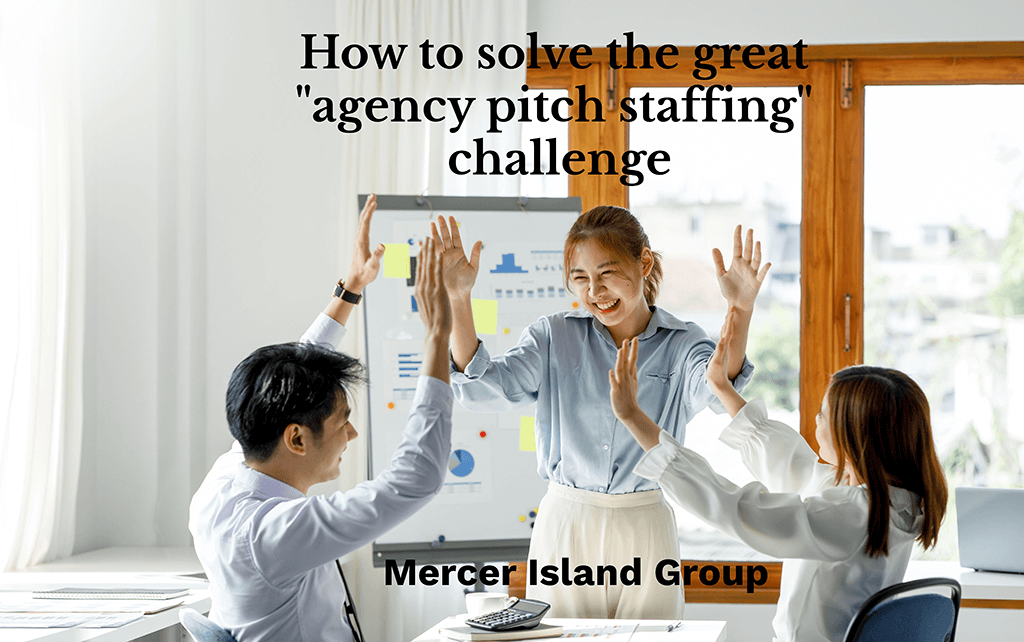Our friend Scott Davis, an EVP at the fine, independent media agency Harmelin, recently challenged us to write a blog on agency pitch staffing. Here is a lightly edited version of his note:
If I could be so bold as to suggest a topic that is of particular interest (and frustration) to me – it relates to how early in the process prospects are asking to “meet the team that will work on the business.” I completely understand the need for a company to not just meet the agency, but the people they would work with. However, this request and expectation is coming earlier and earlier in the process – a team org chart is often requested at RFI stage, and the team is usually requested at the first capabilities meeting. As a pitch can span four to six months, this is highly challenging for us as an agency, because none of us have a stable of people idling and waiting for their next assignment.
It is unfair (my opinion) to ask us to put a team “on ice” for months for what might be a one-in-four chance of working with someone. I’m curious if you are seeing this trend as well, and you have the benefit of having both client and agency perspective
Here is my response…
I think there is a happy medium that works for both clients and agencies.
Before I get to that, let me take a moment to highlight how I think we have gotten to this point where clients are hoping to see the people that will work on the business all throughout a very long pitch. I think the largest agencies have trained senior marketers to beware of “bait and switch” pitch staffing practices. Several years ago we saw “the largest media agency in the country” send the same pitch team to three different clients in six months. The presenters were accomplished, smart, articulate and great on their feet. They were all impressive presenters. Unfortunately, they were all SVP department heads in this agency of several thousand employees. The pitches were amazing, yet they lost two out of three. In the two losses the prospect team walked away thinking, “We’ll never see these people again.” There is simply no big-agency business model where such senior execs regularly work on a small or mid-sized client.
Prospects hate bait and switch, where an agency sends a pitch team full of senior, experienced and talented presenters who, after winning a piece of business, are never seen again.
So, what is the right team for a pitch? What is the happy medium that will work for agencies AND clients? I think there is an important difference between working on the business and being the primary day to day staffer from a function. I don’t believe that clients are looking for the primary day to day person from each function to be involved throughout the entirety of a pitch. Rather, they want to see people that will be responsible for the work and function and are close enough to the day-to-day activity that they can speak with confidence about the account. This is a nuanced difference, but one that I believe helps agencies manage the challenges of pitch staffing while still allowing clients to gauge the team they will work with.
Here is an easy test an agency can use in judging if the team is a pitch team or not: if (other than the management sponsor) most executives on the pitch team are not included in the SOW, it’s a pitch team.
In our experience, most clients do not need to see, during the entire pitch, the heaviest billing staffer from each discipline. Rather, an ideal pitch team has:
- The day-to-day agency contact the client will work with
- Execs from each key discipline that are senior enough to be accountable for their function’s support and will bill the account
- A diverse makeup of individuals representative of the prospect’s target audience
- A senior executive or owner that vouches for the agency’s commitment
The agency world, like many professional services, is full of small differences and limited brand awareness. Agencies are pitching new business often and the ability to win more than an agency’s “fair share” is critical to profitability. The ability to run a compelling pitch – especially in a competitive setting – is critical to a high win rate. Staffing a pitch properly can be the difference between success and failure.
Steve Boehler, founder, and partner at Mercer Island Group has led consulting teams on behalf of clients as diverse as Ulta Beauty, Microsoft, UScellular, Nintendo, Kaiser Permanente, Holland America Line, Stop & Shop, Qualcomm, Brooks Running, and numerous others. He founded MIG after serving as a division president in a Fortune 100 when he was only 32. Earlier in his career, Steve Boehler cut his teeth with a decade in Brand Management at Procter & Gamble, leading brands like Tide, Pringles, and Jif.
